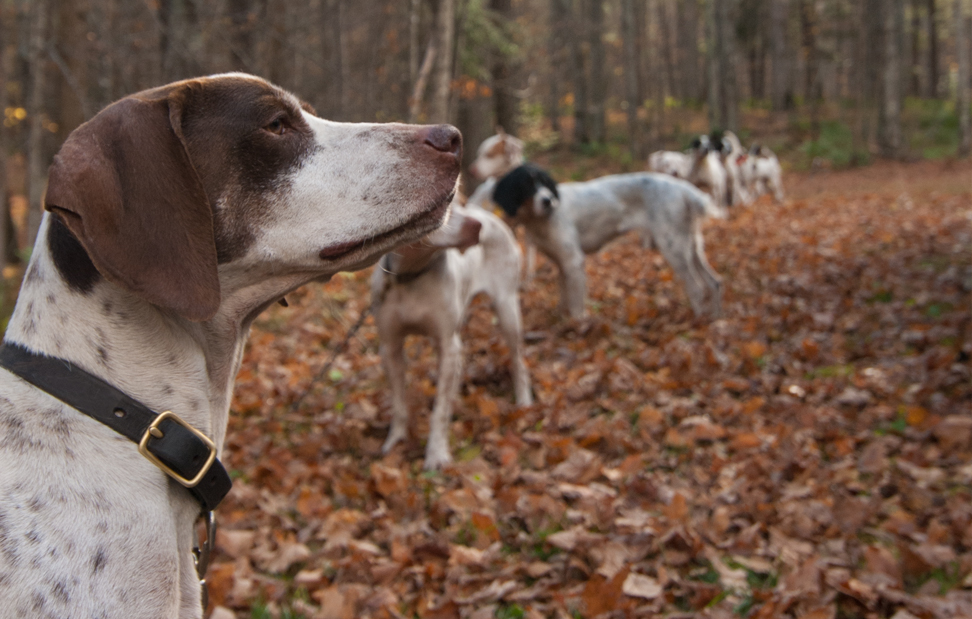Most of us got our start with bird dogs foot hunting on farms where we grew up. For my generation there were huntable populations of quail on farms from Florida north to Indiana and grouse above and in mountains west of that, and of course quail and pheasants to the west. For the small percent of us attracted to pointing dog trials, it was the on-foot fun trials with a bird field and then the weekend one-course horseback trials that first captured our imaginations.
I was lucky to come along in an era of great farm-quail hunting over much of Virginia and a vigorous one-course horseback circuit in Virginia and adjacent states. I loved the on-foot hunting most but the trials too, especially after my law-school mate Bill Anderson of Danville introduced me to Arthur Bean of High Point, North Carolina, a pioneer Shooting Dog trainer-handler who polished the Elhew pointers for Bob Wehle to run in Amateur Championships. Arthur taught me to appreciate class in a dog. He was honest, sober, and a great storyteller, and a total gentleman. Arthur broke several gun dogs for me. Then when Arthur retired Roy Manns of Madison County, Virginia did likewise. Roy had been a career Army Sergeant and cook, and while serving at Camp A. P. Hill at Bowling Green handled bird dogs for the commanding officers.
Judge Lee West of Oklahoma came east to serve as head of (and close down) the Civil Aeronautics Board. He immediately became a part of the Virginia field trial scene and livened it up. He bred and started many good dogs and handled his own in amateur stakes, with Billy Kuser handling them in the opens. Later we would become friends when I reported the Invitational and he judged.
Field trial culture is built on the lore of trials past, tales vaguely remembered and tall tales. Perhaps the most outrageous of these tales, but absolutely true, is the story of the theft in the night of the entire string (eight or nine dogs) of professional Roy Manns off their tie-out chain stretched in the old barn at the Amelia, Virginia Wildlife Management Area just west of Richmond one Saturday night in the 1980s. The really good story is how they were rescued and returned unharmed.
Roy left Buddy’s Motel, just west of the Amelia grounds on Sunday morning, expecting to find his dogs moored as he had left them Saturday after the running, but low and behold they were gone when Roy reached the grounds. At first Roy thought someone was playing a joke on him, but soon it became clear they had been stolen! Roy at once settled on a suspect: a marginal professional from North Carolina we will call Willie (not his real name).
The more Roy thought the more sure he was that Willie was the thief. His absence for Sunday’s running was the first clue. Absent too was the suspicious character Willie had bought as a scout, another clue. But what could Roy do? Suspicion was all Roy had. Then Roy had an epiphany.
Roy remembered an amateur competitor from Goldsboro, North Carolina who had been on hand Saturday at Amelia had told Roy he would be in the neighborhood of Willie’s home on his salesman route Monday. Roy called Lewis Clements Sunday at his home in North Carolina, and Lewis agreed to drive to Willie’s home (a single-wide trailer) and look for Roy’s dogs first thing Monday morning. He doubted Willie would have the dogs there even if he had stolen them.
But low and behold, when Lewis Clements drove to Willie’s single-wide early Monday morning, Willie’s truck was absent. Lewis cautiously parked out of view of the single-wide and walked through woods to the lot in back. There he found all Roy’s dogs, tied to individual pine trees. He still did not know if Willie or members of his family were in the single wide.
He faced a terrible dilemma. Should he lead the dogs away, load them in his car, and escape with them but thereby destroy the objective evidence of Willie’s theft? Or should he go for the sheriff and bring him back to see the dogs tied in Willie’s dog lot?
Lewis decided to put the dogs’ safety first. One by one he led them to his car and put them in the trunk together. When the trunk was full, he put the rest in the back seat. He feared they would fight but they did not. Then he drove to the nearest pay phone and called Roy, who in his truck drove to North Carolina to meet him and take possession of the dogs.
Willie was not prosecuted, for this was before cell phone cameras and Lewis by his rescue of the dogs had destroyed the objective evidence of Willie’s theft. But Willie was not seen again at a field trial in Virginia for many years. And most important, Roy Mann’s string was back winning the following week.
And what of Lewis Clements? At the time of our story Lewis Clements owned and handled a wonderful bird dog, Roll On Kizzy, a daughter of Evolution and winner of the Region 3 Amateur Shooting Dog Championship and many other placements. Mike Gaddis in his wonderful book Zip Zap tells the story of Lewis Clements and Roll On Kizzy at pages 179 and following.
I had known of the theft of Roy’s string since it occurred, but not of how they were recovered. Recently Harold Ray, who was at Amelia that week with the Smith Setters and knew the whole story, called and told me.
